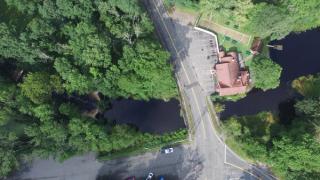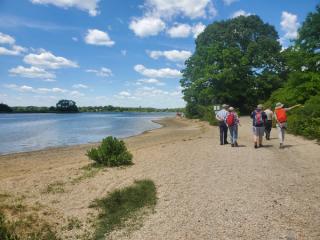
Kikitta Ahki – Floodplain restoration and park design along Whetstone Brook
- Client Name
- Vermont River Conservancy and Town of Brattleboro, VT
- Location
- Brattleboro, Vermont, USA

This project won the Award of Excellence for the 2025 Public Places Awards from the Vermont Chapter of the American Society of Landscape Architects (VTASLA).
SLR worked with the Town of Brattleboro and the Vermont River Conservancy to complete the Whetstone Brook Floodplain Restoration Initiative, a sustainable flood resiliency and park development project. The area was renamed Kikitta Ahki, Abenaki for Really Listen Land. Really Hear Land. Really Sharpen Land.
Challenge
During its industrial past, the floodplain at 250 Birge Street along the Whetstone Brook in the Town of Brattleboro, VT was used for lumber mill and log yard operations, leading to its nickname of “Sawdust Alley”. Long after logging operations had ceased in the area, the property sat dormant as a gated, gravel-filled floodplain filled with invasive poison ivy until it was purchased by the Vermont River Conservancy in 2014.
The Conservancy recognized the importance of this property and sought a plan forward to restore the floodplain in the area and provide the community open spaces to enjoy. SLR was enlisted to help restore and develop this new plan alongside The Conservancy, with additional funding from FEMA’s Hazard Mitigation Assistance Grant Program (HMGP), the Vermont Housing and Conservation Board (VHCB), a Vermont Resilient Communities Grant, and the US Environmental Protection Agency (EPA).
Solution

SLR was selected by the Vermont River Conservancy to design two primary components:
- Floodplain restoration – Once the built-up gravel was removed, to provide the engineering support to allow the floodplain to slow and spread within the property during high-water events.
- Park design – Prioritizing community need, public outreach events were held to identify park amenities and land use preferences, to design a rustic park that can accommodate flooding.
SLR began the Whetstone Brook Restoration Project by first addressing the largest of the impacting problems, 50+ tons of gravel that filled the property and prevented the floodplain from acting as a natural outlet for rising waters, increasing local flood and erosion risks. Areas downstream and adjacent to the park were damaged during Tropical Storm Irene in 2011, including roads, sewer and water lines, sidewalks, and 52 homes and commercial properties.
The project began with the removal of 50,000 cubic yards of clean gravel fill for reuse and excavated approximately 8,000 cubic yards of PAH contaminated soil, which was treated and buried on site, to reduce project cost.
Floodplain restoration
With the gravel addressed, the next step for the SLR Water Resources Engineers was to remove the invasive species that occupied the property and begin to restore the area with native, vegetation, such as riverside trees and shrubs in the 100-foot buffer of the brook, creating wetland and riparian area buffers. Native seed mixes were applied on the floodplain based on the post-excavation moisture content. The adjacent wetland was restored through the removal of dumped trash, the installation of large wood, and native plantings.
Whetstone Brook floodplain restoration design cross section and site plan
Park design
During the design phase of the park, public outreach events were held to identify park amenities and preferred community land use. Rustic park amenities compatible with flooding, such as an informal trail network, boulder seating (instead of manmade seating, which would become a problem during flooding) and at-grade parking were incorporated into the design.
Members of the community expressed their desire for an edible landscape, an ADA-accessible fishing spot, protection of an area often used by deer to raise their fawn in the spring, and the preservation of a large willow tree that is a landmark on the parcel.
State and federal partners also positively influenced the design, including the design of pathways and the alteration of the grading plan to allow in-situ preservation of an Abenaki tool making/sharpening remnants (the Abenaki People were the indigenous Tribespeople who occupied the land along Whetstone Brook before European settlement), to preserve historical cultural significance of the site.
The project spanned two construction seasons, so a winter shutdown took place where the excavation area was temporarily isolated from Whetstone Brook to control sediment and erosion. The project was completed on schedule and on budget.
Impact
The park has become a teaching opportunity for the community and region with schoolchildren producing a fluvial geomorphology interpretive dance, and others hanging river poems from the landmark willow tree. Groups interested in flood resiliency, urban forests, and edible landscapes from Massachusetts, New York, and Vermont have visited the site to inspire their own restoration/community development projects.
Senator Welch reading poems from local students
Recognition of the Abenaki People
Efforts are underway to honor the Abenaki heritage on the parcel. In addition to the name Kikitta Ahki, a local Abenaki speaker is helping develop signage showing the native names of flora and fauna found in the park. Signage will include a link to a video recording including pronunciation of Abenaki names and a recording of children of Abenaki heritage spear fishing for eels on the old mill dam at the upstream end of the parcel.
As Vermont communities seek to reduce flood risks in the wake of large floods over the past two years, this project is an important example of improving local flood storage in a community while also expanding recreation opportunities.








